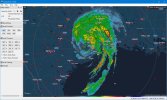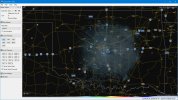RandyDSok
Well-Known Member
Supercell Wx - free open source radar program
Quoting their main doc webpage...
"Supercell Wx is a free, open source application to visualize live and archive NEXRAD Level 2 and Level 3 data, and severe weather alerts. It displays continuously updating weather data on top of a responsive map, providing the capability to monitor weather events using reflectivity, velocity, and other products. Extended functionality, including weather reports and lightning data can be added using placefiles."
Like many radar apps and programs, I believe this is limited to use within the USA since they ( the government ) provide free direct access to the actual radar data on their NEXRAD radar sites. While not as mature as the GrLevel products, it provides a lot of similar features. This is available for both Linux and Windows OS. Supercell WX works with GrLevel compatible color pallettes and placefiles. The L3 radar uses super resolution products which are close to the resolution of the better L2 radar as well as can be downloaded quicker since they are pre-compiled data unlike L2 which is raw data and needs processed before you can view them. L2 products still are better if for no other reason than you can do additional processing beyond what is provided by the default L3 data. Supercell WX hasn't matured enough yet to provide any additional processing features, perhaps it may in the future.
This is a single radar site program and does not provide a national mosaic. You are able to view up to 4 panes of radar data in the one window.
More info and links to the downloads can be found on Supercell Wx — Supercell Wx documentation
Here is a screenshot of the Houston radar while hurricane Beryl is passing through. I have setup my own custom color palettes and added a few placefiles as well.

As a sidenote... After Beryl made landfall, it produced over 100 tornado warnings ( unsure if that was in total or at one point in time ) with what is currently estimated of having 30 - 45 actual tornadoes touch down. The exact numbers of touchdowns are currently unknown and will take a considerable amount of time to verify precisely.
Quoting their main doc webpage...
"Supercell Wx is a free, open source application to visualize live and archive NEXRAD Level 2 and Level 3 data, and severe weather alerts. It displays continuously updating weather data on top of a responsive map, providing the capability to monitor weather events using reflectivity, velocity, and other products. Extended functionality, including weather reports and lightning data can be added using placefiles."
Like many radar apps and programs, I believe this is limited to use within the USA since they ( the government ) provide free direct access to the actual radar data on their NEXRAD radar sites. While not as mature as the GrLevel products, it provides a lot of similar features. This is available for both Linux and Windows OS. Supercell WX works with GrLevel compatible color pallettes and placefiles. The L3 radar uses super resolution products which are close to the resolution of the better L2 radar as well as can be downloaded quicker since they are pre-compiled data unlike L2 which is raw data and needs processed before you can view them. L2 products still are better if for no other reason than you can do additional processing beyond what is provided by the default L3 data. Supercell WX hasn't matured enough yet to provide any additional processing features, perhaps it may in the future.
This is a single radar site program and does not provide a national mosaic. You are able to view up to 4 panes of radar data in the one window.
More info and links to the downloads can be found on Supercell Wx — Supercell Wx documentation
Here is a screenshot of the Houston radar while hurricane Beryl is passing through. I have setup my own custom color palettes and added a few placefiles as well.

As a sidenote... After Beryl made landfall, it produced over 100 tornado warnings ( unsure if that was in total or at one point in time ) with what is currently estimated of having 30 - 45 actual tornadoes touch down. The exact numbers of touchdowns are currently unknown and will take a considerable amount of time to verify precisely.



